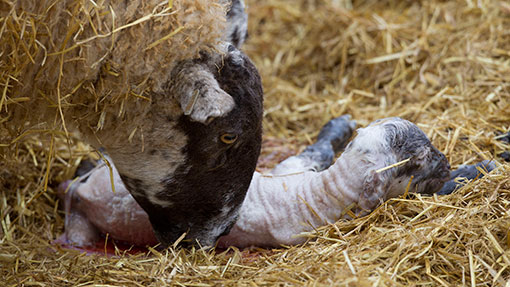How to prevent prolapse in over-fit ewes

Farmers should highlight pregnant ewes in over-fit condition and take action to prevent prolapses at lambing, experts are warning.
ADAS sheep consultant Kate Phillips says following the extended autumn grazing there is a high chance ewes could be in an over-fit condition, leading to an increase in prolapses.
“While some people believe prolapse is due to genetics, it is more likely down to feeding,” she says.
What causes a prolapse?
- When the abdomen is filled with fat, the squeezed abdominal contents seek a way out as the ewe becomes more heavily pregnant.
- The weight of the uterus stretches ligaments that hold it in place and when pressure builds the uterus will be squeezed towards the exit.
- Lowland-housed ewes are more likely to prolapse, as they tend to have more lambs so internal pressure is greater, or in older ewes as the ligaments get slacker.
- Culling any ewe that prolapses is usually advised to prevent the likely recurrence.
Body condition scoring
For flocks due to lamb March-April, Ms Phillips says it is critical to body condition score (BCS) ewes now so they can be grouped appropriately for feeding arrangements.
“Feel the loin area for fat and muscle coverage (fat is soft, muscle is firm) and the backbone to see how easily the horizontal parts of the vertebrae can be felt,” she says.
Lowland ewes should be BCS 2.5-3 depending on whether they’re lambing indoors or out. Hill/upland ewes should be about BCS 2.5, she adds.
Condition scores
- No loin muscle or fat, backbone feels sharp
- Shallow loin muscle with little fat, backbone feels smooth and round
- Deep loin muscle covered with thick fat, backbone only felt with pressure
- Full, rounded loin muscle covered with thick fat, horizontal parts of backbone undetectable
- Very full loin covered with very thick fat, visible dimple in fat layer where backbone is, but it cannot be felt
Feed planning
Once condition scored, Ms Phillips suggests leaving over-fit ewes outside grazing for a week or two longer or brought indoors, but with the same delay on feeding concentrates.
Feeding arrangements for over-fit ewes are also important, she says: “I do not like restricting forage as it causes ewes to rush forward to eat, putting more pressure on their abdomens.
“Silage should be analysed as it can range from 9-11ME. Keep the best quality for nearer lambing and use poorer quality now,” she adds.
Vet Paul Roger of Veterinary Consultancy Services says any changes to diet or feeding regime should be made after discussion with the farm’s nutritionist and vet.
“It takes approximately six weeks to alter a ewe’s condition by one BCS. The last thing needed six to eight weeks before lambing is to reduce intake or energy density, due to the maximum growth period of the lamb,” he adds.
Financial implications
Premature labour can be stimulated by a prolapsed damaged cervix, leading to tears in the uterus and infection. Mr Roger says not only can this damage a ewe’s future productivity, the exposed vulva and lack of hygiene also puts other ewes at risk.
Ms Phillips says the cost of treating a prolapse or losing ewes with lambs inside is enormous.
“If a ewe cost £140, plus two lambs at £80 each, it soon adds up, and that’s without cost of rearing or attempts to treat prolapse with antibiotics or anti-inflammatories.”
(More on preventing lamb losses)
